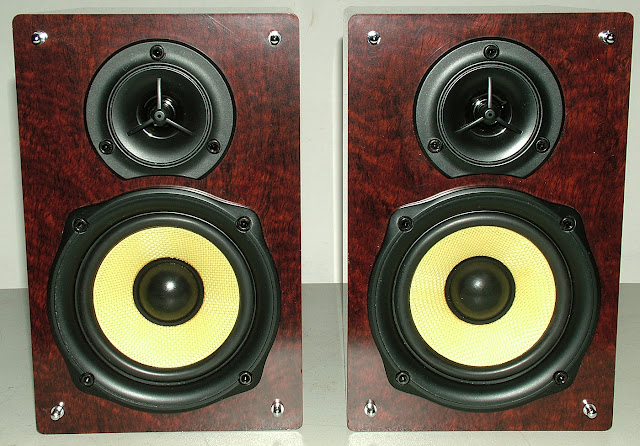Gentle reader,
Last time we left off with the small but very expensive (but not to me: $10!) Spendor LS3/5A British-made licensed copies of the BBC designed mini-monitors.
Now, we start with the "T"s. This first pair, another found-in-their-original-box speakers. Unlike vintage toys, they are pretty useless still in their packaging.
I don't recall researching these, as to their history and position in the speaker hierarchy. However, they are nice looking and I recall they sounded nice.
Note, the tweeter domes were spray painted and the vibration seems to have knocked some paint off.
Next is Tannoy, a legendary speaker maker that is still in business and believers in coaxial drivers. Similar to car speakers, the tweeter is mounted in the center of the woofer. Their thinking is that since in real live all sound emits from a single source, so should it when reproduced. As you can see, these speakers do not follow that logic:
Canadian, eh? As you can see, the cabinets while small are still made of 3/4" MDF. Many makers often choose thinner material which can vibrate or resonate.
Next, the Tang-Band speakers I thought would fit in the Minimus 11 die-cast cabinets. So far, no one seems interested in taking them from me via ebay.
Quite robustly made. The other one's serial number is 007! James Bond, are you missing something?
Below are some pretty speakers made by TEAC.
The woofer cones are a woven fabric of some kind. Note how they notched the bottom of the tweeter frame to bring it closer to the woofer.
They've gotten very good at making plastic look like wood.
This photo was made to show that the factory spring terminals are 3/4" spaced and large enough to accept double banana plugs.
Next, the very old University brand speaker that when I found it had a 16 ohm Wharfedale woofer in it. I added a 16 ohm tweeter to make it sound better. Then featured it in a post. Later, I sold those two bits and adapted this Alpine car stereo woofer to the cabinet. This speaker was designed to sit in a corner. The rear waves from the back of the woofer came out through the bottom. Corner placement increases bass sound.
Next, shows the steps I took to make it sound better in vintage form. The aforementioned horn tweeter mounted in the original plywood baffle. That's what they call the wood that the components are mounted on.
Above is the crossover I installed for the woofer/tweeter and below, the biamplify-able speaker terminals that are wired to it.
Above is what it looked like when I got it, less the woofer. Here is the woofer that I refoamed. Of course there was no correct foam surround, so I overcame thusly:
This woofer mounted from the rear as all did in those days. The green felt served as a gasket.
Were getting near the end now, a pair of vintage speakers of which I could find NO information even though the makers address was on the back!
A shame the one grille was stained. Classic 1960's design. The grilles were glued on, and fear of damaging them kept me from prying them off to see what they hid.
Check out that pretty walnut veneer! Here's what the rear revealed:
As you can see, no access from the back either!
Below, classic Wharfedale units.
These were attached to one of the speakers, a wealth of information!
Note, above from "BRITISH INDUSTRIES CO". Not to be confused with B.I.C which is similarly named, and once made speakers and turntables in the USA. They still sell that brand, but Asian made.
Now, some more recent Wharfedales, Diamond 7.1 units:
Wharfedale still makes speakers and they are highly renowned. I covet several that they produce.
Lastly, a pair of Yamaha speakers that I gave to my son.
While the drivers appear to be metallic, they are merely silver colored paper. They still make some very similar to these.
That's it for speakers that I HAVE known and have photos of. As you know if you follow my blog, there are many that I STILL know and love the sound of.
Thanks for looking,
Scott
















































It's the same B.I.C. You can find flyers online for their famous Venturi line of speakers from the 1970s that have "British Industries Co. Westbury, N. Y." at the bottom. Westbury is around 5 miles from Port Washington, I suppose they just moved down the road in the meantime.
ReplyDeleteThanks for reading my blog! That is more information than I knew. My very first turntable, 49 years ago, was a B.I.C 940.
Delete